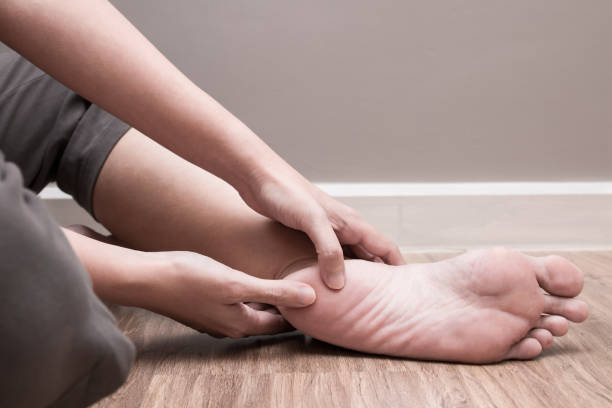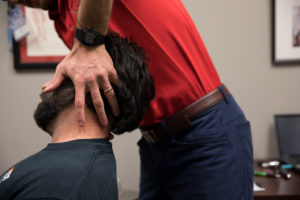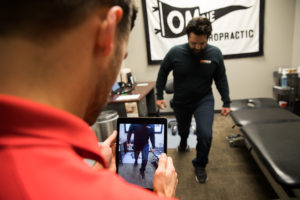Did you know Plantar Fasciitis is the most common cause of heel pain in adults?
Plantar Fasciitis is a big buzzword in musculoskeletal medicine, much like sciatica. However, not all heel pain is plantar fasciitis.
A correct diagnosis is an important first step (pun intended) in recovering from plantar fasciitis.
Speaking of the first step… One of the cardinal signs of plantar fasciitis is sharp, stabbing pain with the first few steps in the morning or after a period of rest.
Who gets plantar fasciitis?
There are two main populations that are susceptible to getting plantar fasciitis. Athletic populations (runners) and individuals that work on their feet (laborers, hair stylists, doctors, teachers, nurses, etc)
Plantar fasciitis is a clinical diagnosis that can be determined in our Omaha chiropractic office without the need for advanced testing like MRIs and X-rays.
We see many different types of foot pain and running injuries with plantar fasciitis being the most common. With all conditions that present to our office, the initial assessment guides our unique treatment approach that includes chiropractic adjustments, muscle therapy, and functional rehab exercises. Plantar fasciitis is a condition that typically requires all three to fully resolve.
What are some common risk factors for developing plantar fasciitis?
- Tightness/weakness in the calf musculature
- Limited joint mobility in the foot/ankle
- Excessive loading with running or standing
- Intrinsic foot muscle weakness
- Overpronation / “Flat Feet” / Fallen Arches
- Supination / Rigid Foot Type / High Arches
- Weight-bearing professions
- Poor Footwear Choices
- Overtraining
Plantar Fascia Anatomy
The plantar fascia is a fibrous band of connective tissue that helps support the medial longitudinal arch of the foot. The two main jobs of the plantar fascia are to support the arch and dynamic shock absorption. Plantar fasciitis can develop in individuals with both high arches and flat feet.
Plantar fasciitis is a form of overuse injury where repetitive microtrauma and excessive strain results in pain and dysfunction. Remember, the plantar fascia provides static support to the arch and dynamic shock absorption. Keeping this in mind, it is easy to see why it can affect both flat-footed and high-arched individuals.
I have pain, if it’s not plantar fasciitis – What else could it be?
Not all foot pain is plantar fasciitis. There are several common conditions in the foot that could be causing a similar presentation.
These include:
- Achilles Tendinitis/tendinopathy
- Sever Disease (pre-teen children)
- Baxter Nerve Entrapment
- Tarsal Tunnel Syndrome
- Calcaneal stress fracture
- Heel Spurs
- Bruised Heel Pad or Heel Pad Atrophy
Our Chiropractic Approach to Plantar Fasciitis
OMNE Chiropractic offers a unique approach to the treatment of plantar fasciitis. Providing runners and workers in Omaha, Nebraska relief from plantar fasciitis is very important to us.
Flat foot considerations:
In patients with flat feet, too much strain is placed on the plantar fascia due to lack of muscle strength and support from the intrinsic foot musculature. Our chiropractic treatment approach for these individuals is focused on arch formation exercises and intrinsic foot strengthening. We offer symptom relief through stretching, muscle therapy, and adjustments while building the arch back into the foot with in-office and at-home exercises.
High arched considerations:
A rigid foot type causes excessive strain on the plantar fascia because the joints of the forefoot, midfoot, and ankle do not appropriately attenuate shock from running, jumping, or standing. I like to think about a pirate running with a peg leg to highlight the importance of having a supple and mobile foot and ankle. Our chiropractic treatments mobilize the foot and ankle to lessen the strain placed on the plantar fascia. In-office stretching, muscle therapy, dry needling, and functional exercises allow the whole musculoskeletal system to better handle the stressors of running or working on your feet.
Our chiropractic services for plantar fasciitis include:
- Chiropractic adjustments to the foot, ankle, and pelvis
- Muscle therapy to the foot, calf, and lower extremity
- Dry Needling to the muscles of the lower leg
- Load Management – advice on running and working to aid in recovery
- Functional Rehab in office and at home, including Calf Raises, banded toe extension, Arch formation
- Orthotics: pedograph and casting
I don’t think you will find a more comprehensive, conservative approach to plantar fasciitis treatment in Omaha.
What our patients say:
Plantar Fasciitis FAQs
Do I need an orthotic for plantar fasciitis?
Orthotics are a common intervention for plantar fasciitis. Our chiropractic approach considers orthotics an option in the extremely flat-footed presentation where additional support is needed outside of our functional rehab exercises. Our Omaha Chiropractic office recommends starting with an off-the-shelf orthotic prior to custom orthotic fabrication and these products are available at local running stores.
In certain cases, a custom orthotic may be warranted and we have partnered with Shawn Eno of Xtreme Footwerks to build orthotics for our patients.
How long will my plantar fasciitis last?
Plantar fasciitis typically resolves in less than six months although some more stubborn cases take longer. Many patients of our Omaha chiropractic office get relief from symptoms much sooner than six months and get the exercises and tips to prevent reoccurrence.
We partner with our local foot/ankle orthopedic surgeons and podiatrists to handle the more difficult plantar fasciitis cases that may require additional intervention.
What is the best treatment for plantar fasciitis?
There is no one BEST treatment for plantar fasciitis. A conservative approach that involves stretching, strengthening, mobilization, and exercises is recommended. The majority of plantar fasciitis cases will respond favorably to these types of treatment with only rare cases requiring injections or surgery.




